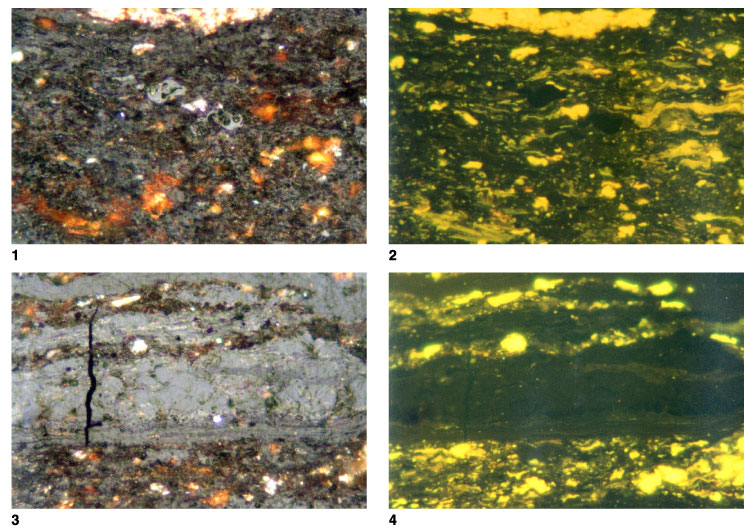
Plate P9.
Coal and shaly coal. 1.
T5818; Hole 1109D; 969.89 mbsf. Shaly coal. Possible in situ roots are present
in some horizons, but in Hole 1109D some of the deeper samples represent
hypautochthonous peats. It is possible that these samples represent intraclasts,
but an indigenous origin is more probable. This field shows a shaly coal with
detrovitrinite, resinite, sporinite, and liptodetrinite. Liptinite-rich horizons
such as this are typical of peat swamps but not of fringing marine settings in
the Tertiary (reflected light; field width = 0.22 mm; detrovitrinite reflection
= 0.30%). 2. T5818; Hole
1109D; 969.89 mbsf. Same as figure 1, but in fluorescence mode. Shaly coal with
detrovitrinite, resinite, sporinite, and liptodetrinite (reflected light; field
width = 0.22 mm; detrovitrinite reflection = 0.30%). 3.
T5818; Hole 1109D; 969.89 mbsf. Coal with telovitrinite, detrovitrinite,
resinite, sporinite, and liptodetrinite. The telovitrinite contains some weakly
fluorescing tissues that probably represent periderm, and the telovitrinite may
be derived from root tissues. The textures and maceral composition are not those
typical of mangrove/Nypa swamps, and it is more likely that this peat was formed
in an inland setting (reflected light; field width = 0.22 mm; telovitrinite
reflection = 0.30%). 4.
T5818; Hole 1109D; 969.89 mbsf. Same as figure 3, but in fluorescence mode. The
telovitrinite shows weak fluorescence from some layers, and the resinite,
sporinite, and liptodetrinite all show intense yellow fluorescence. The weakly
fluorescing tissues may represent suberinite-like layers or could have
affinities to cutinite (reflected light; field width = 0.22 mm; telovitrinite
reflection = 0.30%). Click on image or number to see enlargement.



![]()